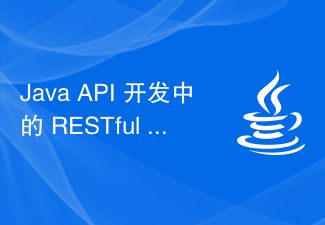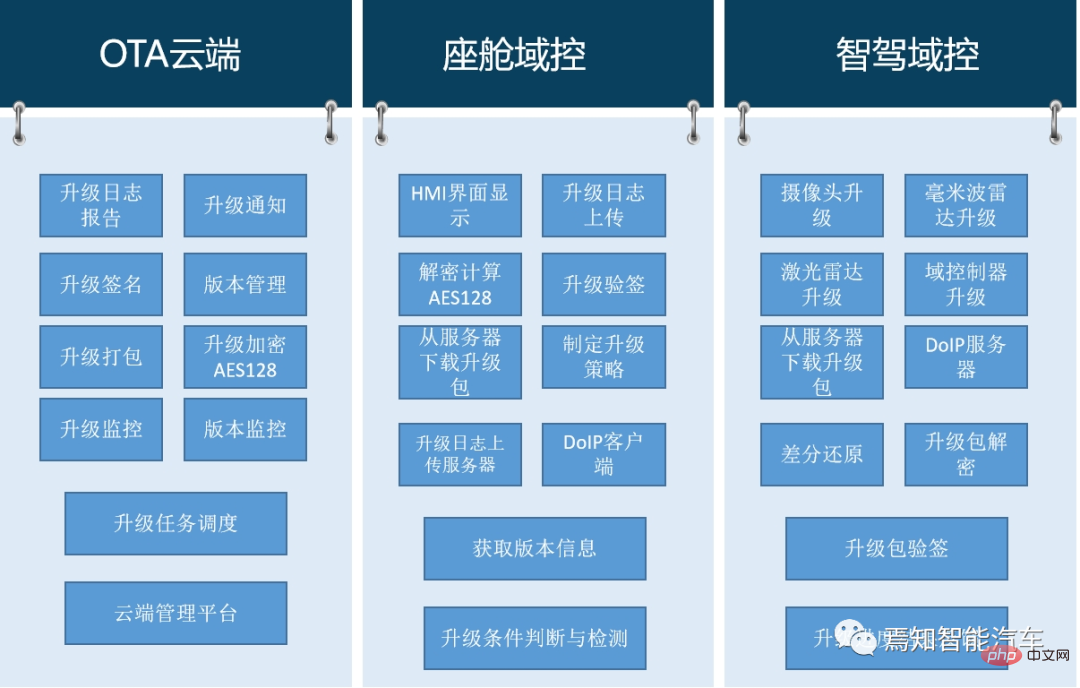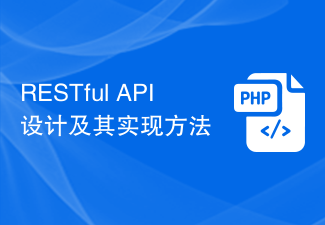With the rapid development of mobile Internet and Web applications, RESTful API has become an important form of Web services. Compared with traditional SOAP and Web services, RESTful API is more lightweight, flexible, and easy to use. As a language widely used in web development, PHP also supports the design and implementation of RESTful APIs. This article will introduce the design and implementation process of implementing RESTful API in PHP.
1. Basic concepts of RESTful API
RESTful API is an API design style based on the HTTP protocol, which usually uses HTTP predicates (GET, POST, PUT, DELETE) for data operations. It uses URI as a resource identifier and supports multiple data formats such as JSON and XML. Compared with traditional web service design, RESTful API is simpler, more flexible, easier to implement, and easier to use, so it has attracted more and more attention from developers.
2. PHP implementation of RESTful API design
- URI design
URI is the core design element of RESTful API, and its structure should conform to RESTful design in principle. The URI should contain the resource name, resource identifier and resource operation, in the following format:
http://domain.com/{resource}/{identifier}/{action}
where resource Represents the resource name, identifier represents the resource identifier, and action represents the resource operation. For example:
http://domain.com/users/1001 // Get the information of user ID 1001
http://domain.com/users/1001/orders // Get the user ID of 1001 Order list of 1001
- HTTP verb design
HTTP verbs (GET, POST, PUT, DELETE) are used to identify operations on resources. RESTful APIs should follow HTTP verbs specifications. Commonly used HTTP verbs and corresponding operations are as follows:
GET: Obtain resources (such as obtaining user information, orders, etc.)
POST: Create new resources (such as creating new users, new orders, etc.)
PUT: Modify resources (such as modifying user information, order information, etc.)
DELETE: Delete resources (such as deleting users, orders, etc.)
- Data format design
RESTful API supports multiple data formats, including JSON, XML, etc. Data is usually transferred using JSON format. PHP provides the json_encode() function for encoding PHP variables into JSON format, and the json_decode() function for decoding JSON format into PHP variables. The following is an example of user information in JSON format:
{
"user_id": "1001", "user_name": "张三", "user_email": "zhangsan@domain.com", "user_phone": "13800138000"
}
3. Implementation of RESTful API in PHP
To implement RESTful API, you need to create A PHP script that writes interface code and implements corresponding resource operations according to the above design principles. The following is a simple example of PHP implementing RESTful API:
// Define global variables
define('DB_HOST', 'localhost');
define(' DB_USER', 'root');
define('DB_PASSWORD', 'password');
define('DB_NAME', 'database');
// Get HTTP verb and URI
$method = $_SERVER['REQUEST_METHOD'];
$uri = $_SERVER['REQUEST_URI'];
// Parse URI
$req_uri = explode('/', $ uri);
$resource = $req_uri[1];
$identifier = isset($req_uri[2]) ? $req_uri[2] : null;
$action = isset($req_uri[3 ]) ? $req_uri[3] : null;
//Operation database
$db = new PDO("mysql:host=".DB_HOST.";dbname=".DB_NAME, DB_USER, DB_PASSWORD );
switch($method) {
case 'GET':
if($resource == 'users') {
if($identifier) {
$stmt = $db->prepare("SELECT * FROM users WHERE user_id = :user_id");
$stmt->bindParam(':user_id', $identifier, PDO::PARAM_INT);
$stmt->execute();
$result = $stmt->fetch(PDO::FETCH_ASSOC);
echo json_encode($result);
} else {
$stmt = $db->query("SELECT * FROM users");
$result = $stmt->fetchAll(PDO::FETCH_ASSOC);
echo json_encode($result);
}
}
break;
case 'POST':
if($resource == 'users') {
// 获取POST数据
$data = json_decode(file_get_contents('php://input'), true);
// 插入数据
$stmt = $db->prepare("INSERT INTO users(user_name, user_email, user_phone) VALUES(:user_name, :user_email, :user_phone)");
$stmt->bindParam(':user_name', $data['user_name'], PDO::PARAM_STR);
$stmt->bindParam(':user_email', $data['user_email'], PDO::PARAM_STR);
$stmt->bindParam(':user_phone', $data['user_phone'], PDO::PARAM_STR);
$stmt->execute();
// 返回插入的数据
$lastInsertId = $db->lastInsertId();
$stmt = $db->prepare("SELECT * FROM users WHERE user_id = :user_id");
$stmt->bindParam(':user_id', $lastInsertId, PDO::PARAM_INT);
$stmt->execute();
$result = $stmt->fetch(PDO::FETCH_ASSOC);
echo json_encode($result);
}
break;
case 'PUT':
if($resource == 'users' && $identifier) {
// 获取PUT数据
$data = json_decode(file_get_contents('php://input'), true);
// 更新数据
$stmt = $db->prepare("UPDATE users SET user_name = :user_name, user_email = :user_email, user_phone = :user_phone WHERE user_id = :user_id");
$stmt->bindParam(':user_name', $data['user_name'], PDO::PARAM_STR);
$stmt->bindParam(':user_email', $data['user_email'], PDO::PARAM_STR);
$stmt->bindParam(':user_phone', $data['user_phone'], PDO::PARAM_STR);
$stmt->bindParam(':user_id', $identifier, PDO::PARAM_INT);
$stmt->execute();
// 返回更新的数据
$stmt = $db->prepare("SELECT * FROM users WHERE user_id = :user_id");
$stmt->bindParam(':user_id', $identifier, PDO::PARAM_INT);
$stmt->execute();
$result = $stmt->fetch(PDO::FETCH_ASSOC);
echo json_encode($result);
}
break;
case 'DELETE':
if($resource == 'users' && $identifier) {
// 删除数据
$stmt = $db->prepare("DELETE FROM users WHERE user_id = :user_id");
$stmt->bindParam(':user_id', $identifier, PDO::PARAM_INT);
$stmt->execute();
echo json_encode(array('status' => 'ok'));
}
break;}
?>
The above code implements the four functions of GET, POST, PUT, and DELETE of the RESTful API operations. The GET operation is used to obtain user information and user list, the POST operation is used to create new users, the PUT operation is used to update user information, and the DELETE operation is used to delete users. PDO is used here to operate the MySQL database, and the json_encode() and json_decode() functions are used to encode and decode the JSON format.
4. Summary
As a language widely used in Web development, PHP also supports the design and implementation of RESTful APIs. This article introduces the basic concepts, design principles and implementation methods of implementing RESTful API in PHP. I hope it can be helpful to PHP developers and users of RESTful API.
The above is the detailed content of Design and implementation of RESTful API in PHP. For more information, please follow other related articles on the PHP Chinese website!
 iPhone 16的设计特点是堆叠式后置感光元件Aug 11, 2023 am 10:17 AM
iPhone 16的设计特点是堆叠式后置感光元件Aug 11, 2023 am 10:17 AMiPhone16系列将在全线型号也采用堆叠式后置感光元件设计。该设计在今年的iPhone15标准版上已有类似的应用。今年的标准版iPhone15和iPhone15Plus预期将配备一个4800万像素的后置镜头,并使用能够捕捉更多光线的堆叠式CMOS影像感光元件(CIS)设计。新感光元件设计的产能问题,导致苹果无法在所有iPhone15型号上全面采用此设计。尽管索尼的高端CIS产能预期将在2024年前持续紧张,但Apple已提前确保了大部分的Sony订单。根据郭明錤的说法,索尼产能紧张,将对竞争对
 在线投票系统的设计与实现Aug 09, 2023 am 10:13 AM
在线投票系统的设计与实现Aug 09, 2023 am 10:13 AM在线投票系统的设计与实现随着互联网的不断发展,在线投票系统成为了一种非常方便和高效的方式来进行民意调查和选举。本文将介绍在线投票系统的设计和实现,并附带一些代码示例。一、系统设计功能需求分析在线投票系统主要具备以下功能:用户注册与登录:用户可以通过注册账号并登录系统来参与投票活动。创建投票:管理员可以创建投票并设定投票的相关参数,如投票主题、选项内容和投票截
 Java API 开发中的 RESTful 接口设计Jun 18, 2023 am 08:31 AM
Java API 开发中的 RESTful 接口设计Jun 18, 2023 am 08:31 AM随着互联网技术的发展,RESTful风格的API设计成为了最为流行的一种设计方式。而Java作为一种主要的编程语言,也越来越多地在RESTful接口的开发中扮演着重要的角色。在JavaAPI开发中,如何设计出优秀的RESTful接口,成为了一个需要我们深入思考的问题。RESTful接口的基本原则首先,我们需要了解RESTful接口的基本原则。REST即Re
 Go语言中的面向服务架构设计Jun 04, 2023 am 09:51 AM
Go语言中的面向服务架构设计Jun 04, 2023 am 09:51 AM随着互联网技术的不断发展,面向服务架构(SOA)的理念越来越受到人们的重视。在这个背景下,Go语言作为一种高效、可靠的编程语言,也逐渐成为了很多企业与开发者实现SOA的首选语言。本文将深入探讨Go语言中的面向服务架构设计。一、SOA简介面向服务架构是一种软件设计的架构风格,它将复杂的系统拆分成多个相互独立、可复用的服务,每个服务都有独立的功能实现,并使用标准
 自动驾驶汽车的软件升级技术管理与监管策略分析May 16, 2023 am 08:40 AM
自动驾驶汽车的软件升级技术管理与监管策略分析May 16, 2023 am 08:40 AM随着智能车辆在网联化、智能化及架构技术的发展,汽车无论是在固件还是软件上都已经不可逆转的需要进行软件迭代升级。要求在汽车生命周期内会不断的基于汽车OTA能力为整车提供软件升级、固件升级、售后服务等服务能力,可以说,汽车的智能化更迭对于OTA升级能力已经成为不可或缺的主流趋势。本文章将针对自动驾驶汽车的软件升级现状需求及监管要求等进行详细的描述。意在帮助读者整体了解自动驾驶中的软件升级过程原理、准入要求及其应对策略。1整车软件升级技术优势首先,软件定义汽车推动了整车软件升级技术的发展与应用,通过整
 RESTful API设计及其实现方法Jun 22, 2023 pm 04:07 PM
RESTful API设计及其实现方法Jun 22, 2023 pm 04:07 PMRESTfulAPI是目前Web架构中较为常用的一种API设计风格,它的设计理念是基于HTTP协议的标准方法来完成Web资源的表示与交互。在实现过程中,RESTfulAPI遵循一系列规则和约束,包括可缓存、服务器-客户端分离、无状态性等,这些规则保证了API的可维护性、扩展性、安全性以及易用性。接下来,本文将详细介绍RESTfulAPI的设计及其实现方
 Redis应用实例分享:文章点赞功能设计Jun 20, 2023 am 09:30 AM
Redis应用实例分享:文章点赞功能设计Jun 20, 2023 am 09:30 AM在互联网时代,文章阅读与分享已经成为人们日常生活中必不可少的一部分。然而,对于文章的点赞与收藏功能来说,用户体验体现的非常关键。而Redis作为一个高性能的键值存储数据库,在文章点赞与收藏功能的实现中有很大的优势。本文将分享一个基于Redis实现的文章点赞功能设计。功能设计文章点赞功能的设计过程中,需要考虑到许多因素。首先,需要将点赞接口暴露给用户,用户可随
 如何使用Go语言进行代码安全性设计Aug 02, 2023 pm 05:29 PM
如何使用Go语言进行代码安全性设计Aug 02, 2023 pm 05:29 PM如何使用Go语言进行代码安全性设计在当今互联网时代,代码安全性是一项至关重要的任务。无论是为了保护用户的隐私还是避免遭受黑客攻击,代码安全性都是必不可少的。Go语言作为一种现代化的编程语言,提供了许多功能和工具,可以帮助我们进行代码安全性设计。本文将介绍一些在Go语言中实现代码安全性的最佳实践,并提供相应的代码示例。输入验证输入验证是代码安全性的第一道防线。


Hot AI Tools

Undresser.AI Undress
AI-powered app for creating realistic nude photos

AI Clothes Remover
Online AI tool for removing clothes from photos.

Undress AI Tool
Undress images for free

Clothoff.io
AI clothes remover

AI Hentai Generator
Generate AI Hentai for free.

Hot Article

Hot Tools

Atom editor mac version download
The most popular open source editor

Notepad++7.3.1
Easy-to-use and free code editor

SAP NetWeaver Server Adapter for Eclipse
Integrate Eclipse with SAP NetWeaver application server.

VSCode Windows 64-bit Download
A free and powerful IDE editor launched by Microsoft

Safe Exam Browser
Safe Exam Browser is a secure browser environment for taking online exams securely. This software turns any computer into a secure workstation. It controls access to any utility and prevents students from using unauthorized resources.





